Coffee connoisseurs know that the key to the perfect cup of Joe is all in the brewing process, and two of the most popular methods are drip coffee vs French press. So, what’s the big deal about these two?
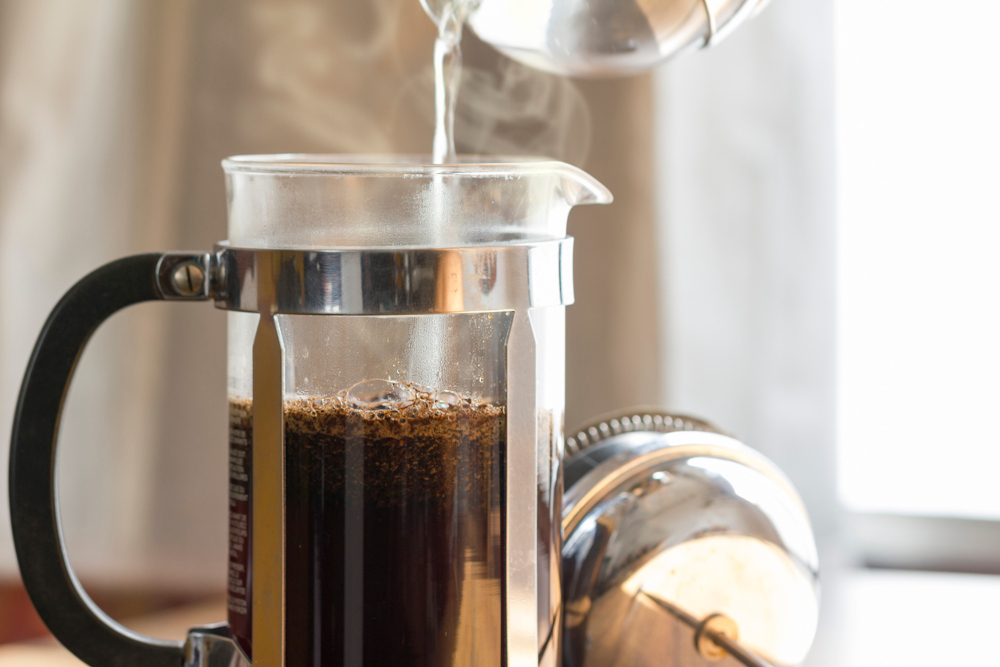
Table of Contents
It might be hard to tell the difference between drip coffee vs French press at first glance. They’re both made with coffee, after all. But there are some key distinctions between the two methods that can make one more appealing for different people.
Let’s take a closer look at each type of brewing and see what sets them apart.
| Drip Brew Coffee | French Press | |
|---|---|---|
| Flavor | Mostly depends on the brewing machine | More intense and with more secondary flavors |
| Caffeine | 60-100 mg per cup | 80-100 mg per cup |
| Brewing time | 5-10 minutes | 8-10 minutes |
| Brewing control | You rely solely on the coffee maker's presets | You determine how the coffee will turn out |
| Ease of use | Easy to use since the entire process is automated | Requires more manual input |
| Required supplies | Coffee machine, paper filter, ground coffee, and water | A French press, hot water, coffee grounds, and a cup or carafe |
| Cleanup | You have to disassemble and clean the removable parts | Just rinse the pot with water |
| Price | A machine can cost as low as $20 | A machine can cost as low as $25 |
Drip Coffee vs French Press – The Basics
Before looking over the pros and cons of drip coffee vs French press, let’s talk about what each of the two brewing methods involves:
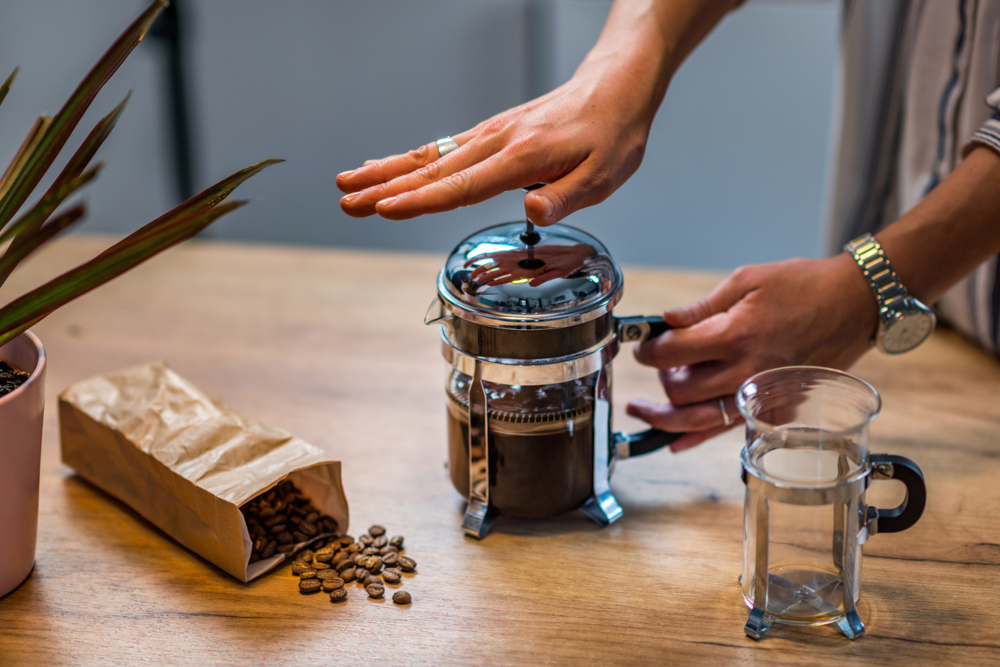
What Is French Press Coffee?
French press coffee, also known as plunger coffee, is made by steeping ground coffee in hot water for several minutes, then pressing down on a plunger to trap the grounds at the bottom of the pot.
This method produces a richer, more full-bodied cup of coffee than drip coffee, and many people believe that it extracts more flavor from the beans.
What Is Drip Coffee?
Drip coffee is made by pouring hot water over ground coffee beans placed in a filter, and the brewed coffee then flows into a cup or carafe.
This is the most common way to make coffee in the United States, and many people believe that it produces a cleaner, more full-bodied cup of coffee than the French press.
Drip vs French Press Coffee – Breaking Down the Key Differences
Now that you know about what each method involves, it’s time we took a closer look at the differences between drip coffee vs French press:
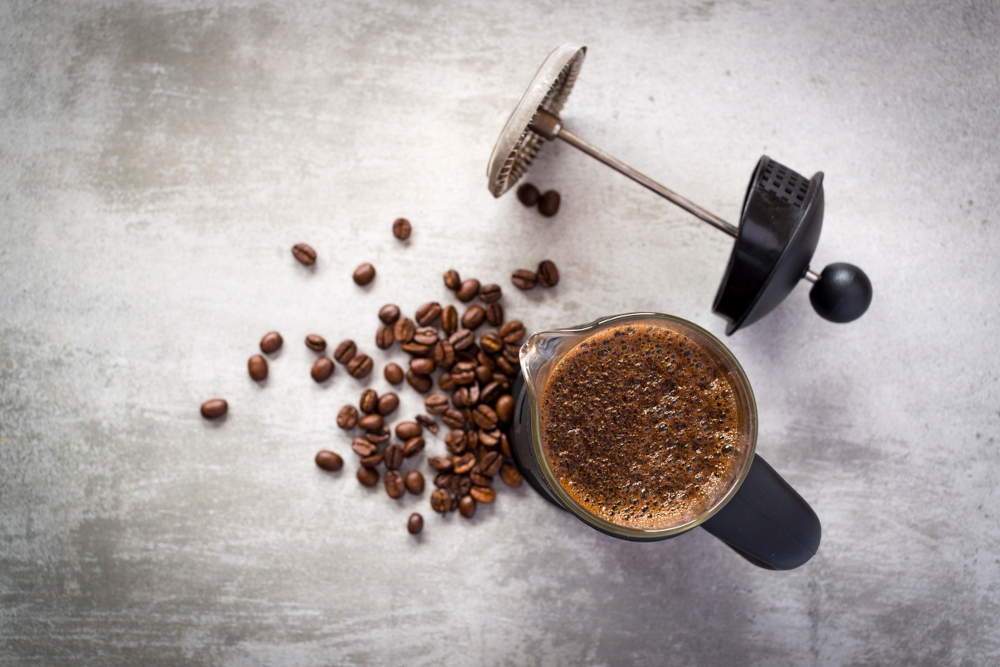
Flavor Quality
You have much more control over all the parameters that can affect the flavor of the resulting coffee when using the French press method. So, those who experience this brewing method will have coffee that’s significantly flavorful.
With drip coffee, there are fewer variables that you can control, and the result can sometimes be a little bland.
Caffeine
Flavor and texture aside, the main reason anyone drinks coffee is to get their caffeine fix. So, French press coffee comes out on top when it comes to drip coffee vs French press.
This is because more caffeine is extracted from the grounds during the brewing process, meaning that you’ll get a more potent cup of coffee using this method.
Besides, several specific factors greatly influence the amount of caffeine:
- Coffee grind – the coarser, the better
- Brewing duration – the longer, the better
- The water temperature – the hotter, the better (ideally 195 to 205°F)
That being said, here’s how much caffeine you’ll be getting from drip coffee vs French press:
- A typical 8-ounce cup of drip brew coffee – 60-100 mg of caffeine
- A typical 8-ounce cup of French press coffee – 80-100 mg of caffeine
Thus, if you’re looking for a bigger caffeine kick, the French press is the way to go. However,if you want something even stronger, check out the drip and percolator coffee differences.
Brew Time
It takes about 5-8 minutes to brew a cup of French press coffee, but if you decide to use a drip machine, you’ll need to wait for about 5-10 minutes. The first few minutes are for heating the device, not making the coffee per se.
This means that the French press is better for making a small amount of coffee or brewing coffee for a longer period so that it has more time to extract all flavors. You might also be interested in learning the differences between Americano and drip coffee.
Brewing Control
A drip brew coffee maker is all about automation, while with the French press, you are in control of every step of the brewing process.
This means that with the French press, you can adjust the flavor profile to your liking by tweaking different variables, whereas, with drip coffee, you are limited to the options that the machine provides.
Ease of Use
When it comes to ease of use in drip coffee vs French press, drip coffee takes the cake.
All you have to do is measure your coffee beans, place them in the filter, and pour hot water – it really can’t be any simpler than that.
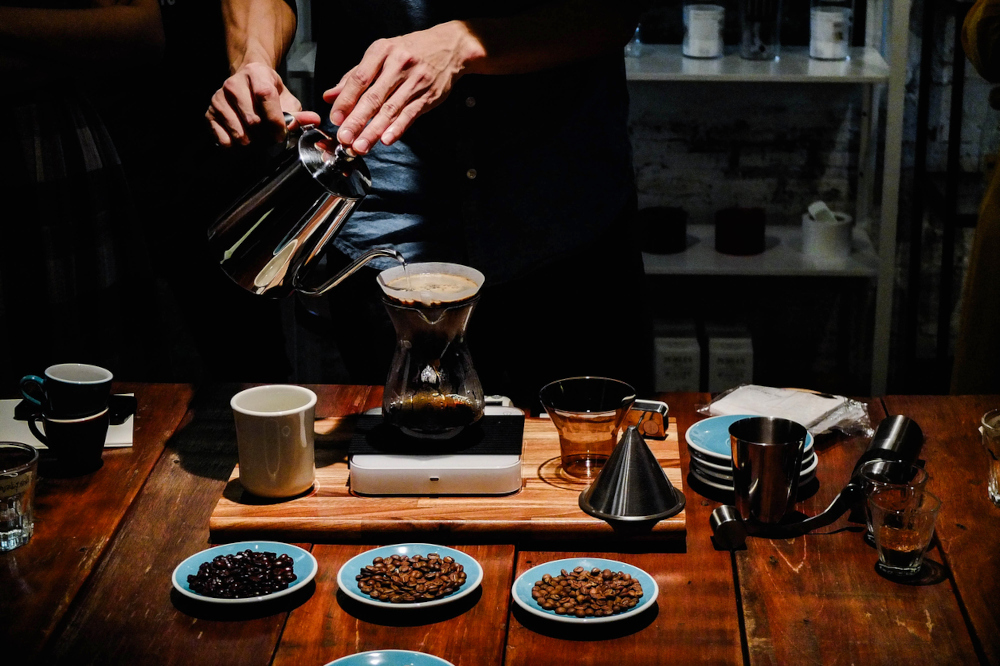
With the French press method, on the other hand, more things must be taken into account to achieve optimal results:
- The grind size of your coffee beans – too fine, and your coffee will be over-extracted and bitter; too coarse, and your coffee will be under-extracted and weak.
- The number of coffee grounds you’re using – too many, and your coffee will be over-extracted and bitter; too few, and your coffee will be under-extracted and weak.
- The brewing time – too short, and your coffee will be under-extracted and weak; too long, and your coffee will be over-extracted and bitter.
Required Supplies
When it comes to the supplies necessary for the drip coffee vs French press brewing methods, both are pretty much tied:
- Drip brew coffee – a coffee maker, water, coffee grounds, and a cup or carafe.
- French press coffee – a French press, hot water, coffee grounds, and a cup or carafe.
Cleanup
The French press is much easier to clean than the drip coffee maker since you have to rinse the pot and plunger with hot water.
Drip coffee makers require you to disassemble the entire machine and clean all parts – a process that can be a little daunting for many coffee lovers.
Price
Drip coffee machines can be found for as little as $20, making them a popular choice for those on a budget. Here’s what you can explore:
- Mr. Coffee 12-Cup – The best budget-friendly choice
- Hamilton Beach 49980A – The best mid-range choice
- Cuisinart DCC-3200BKSP1 – The best premium choice
French press coffee makers are also very affordable, with the most popular models starting at around $25. Here are some good examples:
- BAYKA – The best budget-friendly choice
- Secura – The best mid-range choice
- Mueller Stainless Steel – The best premium choice
The Pros of Drip Brew Coffee
Everyone loves drip-brew coffee, and almost everyone has a drip-brew coffee machine mostly because they are very beginner-friendly, as well as several other reasons, including:
- Drip-brew coffee makers are highly affordable.
- They’re great for people that drink lots of coffee daily.
- Drip-brew coffee makers can keep your coffee warm for longer.
- They’re handy during social events when lots of coffee is needed at once.
- Drip-brew coffee makers take a lot of the guesswork out of the brewing process.
The Pros of French Press Coffee
French press coffee makers aren’t as famous, but that has mostly to do with the fact that you need to have a hands-on approach to brewing. However, there are several reasons why French press coffee is starting to gain some popularity, including:
- They’re perfect for single servings.
- French press coffee makers are incredibly affordable.
- French press coffee makers produce a fuller-bodied cup of coffee.
- Coffee fans prefer the artisanal feel of the French press’ brewing process.
- The filters are reusable, making them more environmentally friendly than other coffee makers.
How to Make French Press Coffee in 9 Easy Steps
Since we’ve already established earlier that making a French press coffee is a bit more complicated, here’s a step-by-step tutorial:
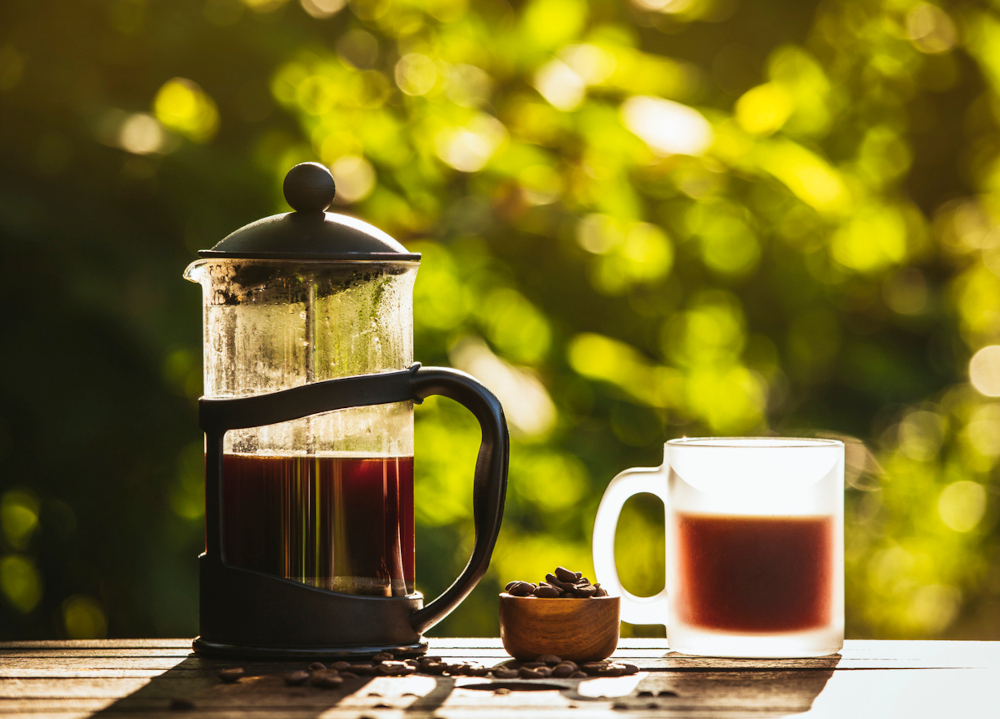
- What you need:
- Burr grinder
- Dark roast coffee beans
- A French press (see examples above)
- A kettle with a thermometer for the hot water
- A cup or carafe
- Preheat your French press by filling it with hot water and then discarding the water.
- Grind your coffee beans to medium-coarse grind size.
- Add the coffee grounds to the bottom of the French press.
- Pour in just-boiled hot water, making sure to fill it to the max line – you’ll want to use around 8 oz of hot water for a 34-oz press.
- Stir the coffee grounds and water together until all grounds are wet.
- Put the lid on the French press and let it steep for 3-4 minutes.
- After 4 minutes, gently depress the plunger down – don’t push too hard, or you’ll end up with over-extracted coffee.
- Pour your French press coffee into a cup or carafe and enjoy!
Drip Coffee vs French Press (FAQ)
Although we have covered the basics in the previous sections, some readers might still have a few questions about the drip coffee vs French press brewing methods.
Can you use drip coffee in a French press?
Yes, you can use drip coffee in a French press. However, it’s not recommended because the results will not be as good as using ground coffee specifically for a French press.
Which is healthier, drip coffee or French press?
There is no significant health advantage to using drip coffee vs French press – both methods produce a caffeinated beverage. However, since French press coffee is brewed longer, more antioxidants will be present in the final product.
What is the difference between French press and drip coffee?
The main difference between drip coffee vs French press is that the coffee grounds directly contact the water with a French press. In contrast, the water passes through the coffee grounds in a filter with drip coffee. This results in a stronger flavor for French press coffee.
Does drip coffee taste better?
It mostly depends on personal preferences, but a French press is perfect if you have a soft spot for intense flavors and lingering aromas. However, suppose you find the taste of coffee to be too bitter. In that case, drip coffee is better since the brewing method produces a more watered-down beverage.
Is drip coffee the same as pour over?
No. With drip coffee, the brewing process happens in a machine. In contrast, with pour-over, the coffee is brewed manually. Also, pour-over coffee often produces a more nuanced flavor profile than drip coffee. Discover more info about pour over and drip coffee.
Final Verdict on Drip Coffee vs French Press
So, what’s the final verdict when it comes to drip coffee vs French press?
Well, it depends on your preferences, so here’s a brief rundown that will make choosing the right brew for you a whole lot easier:
Choose French press if you like to:
- Drink coffee with a rich texture and flavor
- Easily clean the coffee maker after using it
- Control every aspect of the brewing process to create the perfect coffee
Or, go with drip-brewed coffee if you wish to:
- Use a machine that can keep your coffee warm for longer
- Brew larger quantities of coffee at a time
- Drink coffee that’s easy to make
Now that you’re familiar with the pros and cons, it should be a lot easier to choose between drip coffee vs French press. At the end of the day, we recommend trying both methods to see which one suits your preferences better. You should also research the differences between espresso and drip-brewed coffee.
Happy brewing!
Is your bias showing, hmm, maybe? I’ve been a coffee drinker for over 55 years and have tried nearly every way to make coffee. The fact that drip does not create a stronger flavor is precisely why I prefer it. I drink my coffee black and use beans without fruit/nut/artificial flavors, so I drink only coffee. I find French Press to be too much like Espresso, and I find them more bitter. It boils down to personal taste, that’s all. (With the exception of coffee snobs who are really like wine snobs. When someone purports to like something in order to be a part of the ‘in’ group, they themselves are artificial.)